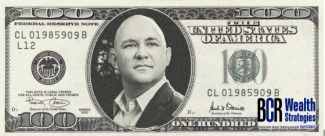
Is the US Dollar’s dominance in danger?
At BCR® we are constantly keeping up with institutional and academic information on the investment markets and world economies to manage our clients’ portfolios. We also keep up with mainstream media to be informed of what our clients may be hearing that we need to be able to explain. On occasion we hear from a handful of clients about concerns and predictions found outside these sources that we investigate.
Recently we have had a few clients bring up claims that government forces in the middle and far east have been conspiring to transfer the US dollar’s dominance to China. Thanks to our friends at Avantis Investors we have information you may find interesting whether you have heard these claims or not.
The US Dollar as a Reserve Currency
The U.S. dollar (USD) has long been the world’s most widely used currency, playing a critical role in global trade and as a store of value for central bank reserves.
From time-to-time predictions centered around potential shorter- and longer-term trends that could increase demand for international currencies, surface. So, are we seeing chinks in the armor of the dollar’s dominance as the world’s leading reserve currency? Let’s look at the data suggesting that’s likely not the case.
|
|
Figure 1 provides the composition of global foreign exchange reserves by currency over the last 20 years.
While the USD’s share of global reserves has declined modestly, it remains the world’s preferred reserve currency, accounting for almost 60% at the end of 2022. This hasn’t been a straight-line decline. In the early portion of the 2010s — following the Great Financial Crisis (GFC) period — reserves allocated to the USD fell to nearly 60% (slightly higher than today) before rising to 66% in 2015 (similar to the peak levels seen in the early part of the sample period).
The gap between the share of USD and EUR, the second most-used reserve currency, has also seen little change over these 20 years (40% on average). After being in line with the average as recently as the third quarter of 2022, this gap was just below the period average at the end of 2022.
With no other currency at more than a 6% share of global reserves, there’s little evidence that any currency has gained meaningful ground on the USD over the last 20 years. We are far from seeing the USD surpassed as the leading reserve currency.
|
|
In Figure 2, we examine another gauge of USD usage by looking at the makeup of foreign exchange transactions by currency.
Because there are two sides to a foreign exchange transaction (i.e., the currency bought and the currency sold), totals for each period sum up to 200%. What stands out is that the USD’s participation in foreign exchange transactions remained remarkably stable from 1989 to 2022. Neither the euro’s introduction in 1999 nor the growth in usage of China’s renminbi had a noticeable effect on the USD’s share over time.
In part, the stability of USD in foreign exchange transactions comes from the outsized role it plays as a medium of exchange in global trade and payments. Federal Reserve (Fed) data shows that from 1999-2019, USD made up 96% of trade invoicing in the Americas and more than 70% for the rest of the world outside Europe, where the euro is the dominant currency.
The Fed’s reporting also shows that the USD is the dominant currency for international banking, with about 60% of international liabilities (mostly deposits) and claims (mostly loans) denominated in USD at the end of 2020, which changed very little from 20 years earlier. *
*Carol Bertaut, Bastian von Beschwitz, and Stephanie Curcuru, “The International Role of the U.S. Dollar,” FEDS Notes, Federal Reserve System Board of Governors, October 6, 2021.
From this data and others, we observe a slight decline in the USD’s share of global foreign exchange reserves over the last 20 years, but the dollar remains the world’s preferred reserve currency.
Further, we find that a decline in the share of reserves doesn’t necessarily mean that currency will depreciate — a potential consideration for investors. When we look at broader usage measures, there’s still no question that the USD continues to be the most heavily used currency in the world.
BCR’s investment philosophy focuses on proven academic approaches to get our clients the expected return they deserve for providing their capital to the market’s economic engines. While we acknowledge that the future remains to be seen, today the dollar’s role in the global economy remains unrivaled.
-Some of the material above was provided by Avantis Investor

